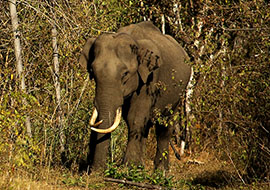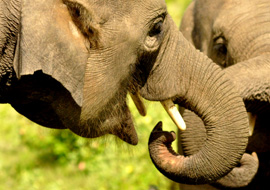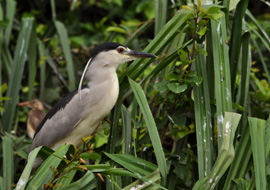

The excitement was at its culmination in Road # 9. I stood on the rear side of the Gypsy holding my camera, which clicked some of my soul-close shots. My mind began to flashback on how I got here to Road # 9. My parents and I decided that we will visit Kanha Tiger Reserve (Madhya Pradesh) for our family holiday and we clubbed a few more cities of historic praise along with our jungle sojourn.
Spread across 1100 sq.km, the vegetation predominantly consists of Sal Trees and Bamboo. The most appreciable part of the administration of this jungle is the manner in which the drives inside the jungle are monitored. Every Gypsy driver is required to furnish details of their guests’ identity to the first check post at Khatiya. We also learnt that every vehicle should have a Forest Guard from the Forest Department. The drivers, as a rule are required to drive only at 30Km/Hr. The Forest guards accompanying the vehicles are given the authority to cease the vehicle if the driver is found speeding. If the Department finds any driver not abiding to the rules, both the driver and the Forest guide are temporarily suspended for a month.
The morning drive inside the jungle starts as early as 4.30 AM and there is a 4 Km drive to the main (second) check post – Kisli. The Kisli check post opens by around 5.30 AM and you get to see the initial signs of dawn.
 The first stop was when a gypsy coming from the opposite direction stopped us and said there were group of Vultures scavenging on a kill. Our Forest guard identified their names immediately as King Vulture and White backed Vulture. The king vulture (Red headed) was feasting on a kill, occasionally allowing the white backed vulture to get a bite of the fortune discovered. Just few meters from the Vulture spot, we saw another bird with its wonder-wings heavy and wide open – the Indian Peacock.
The first stop was when a gypsy coming from the opposite direction stopped us and said there were group of Vultures scavenging on a kill. Our Forest guard identified their names immediately as King Vulture and White backed Vulture. The king vulture (Red headed) was feasting on a kill, occasionally allowing the white backed vulture to get a bite of the fortune discovered. Just few meters from the Vulture spot, we saw another bird with its wonder-wings heavy and wide open – the Indian Peacock.
 Having taken enough shots of the birds, we moved further to explore the Jungle and its mysteries. The scene now comes back to Road # 9 from where we started; 9 AM: It seemed the pre-determined hour for the curtain to rise on the Tiger's activities. Left of us we heard the alarm calls of Spotted Deers and the Langurs. Less than few minutes, we saw a golden and magnificent object moving towards us – a beautiful Tigress. The gypsy drivers, who were aware of the animals crossing path, parked the vehicles little away on either side from the Tigress crossing path. The Tigress came close to the road. I was sure that she will shy away by running too fast to cross the road as there were around 20 vehicles with tourist waiting to catch a glimpse of her; but she proved me wrong. She was crossing calmly with elegance and great poise, as if we had laid the red carpets for her, though it is true in all ways that she is a celebrity. She was a Radio-Collared Tiger, which means she is studied by the wildlife researchers very closely. I later learnt that this Tigress is a mother of three cubs. After crossing the road, she was standing by a bush for two minutes, scanning and scenting the place and eventually moved away from our sights. We moved ahead to drive on the other core areas. In a place called Kanha meadow, in a clearing, we saw a pack of Jackals, claiming the remains of a kill. Pieces of meat were getting ripped and torn apart with the Jackal members of the pack looking happy to hold a meat piece in their mouths. Almost an hour after seeing the Tigress, we returned to our room in Khatiya. Our first morning drive inside the jungle gifted us with many varieties of birds, Swamp Deer (Bhara Singha) – a member of the deer family, Sambar Deers, Spotted Deers, Barking Deers, herds of Indian Gaur and Wild Boar.
Having taken enough shots of the birds, we moved further to explore the Jungle and its mysteries. The scene now comes back to Road # 9 from where we started; 9 AM: It seemed the pre-determined hour for the curtain to rise on the Tiger's activities. Left of us we heard the alarm calls of Spotted Deers and the Langurs. Less than few minutes, we saw a golden and magnificent object moving towards us – a beautiful Tigress. The gypsy drivers, who were aware of the animals crossing path, parked the vehicles little away on either side from the Tigress crossing path. The Tigress came close to the road. I was sure that she will shy away by running too fast to cross the road as there were around 20 vehicles with tourist waiting to catch a glimpse of her; but she proved me wrong. She was crossing calmly with elegance and great poise, as if we had laid the red carpets for her, though it is true in all ways that she is a celebrity. She was a Radio-Collared Tiger, which means she is studied by the wildlife researchers very closely. I later learnt that this Tigress is a mother of three cubs. After crossing the road, she was standing by a bush for two minutes, scanning and scenting the place and eventually moved away from our sights. We moved ahead to drive on the other core areas. In a place called Kanha meadow, in a clearing, we saw a pack of Jackals, claiming the remains of a kill. Pieces of meat were getting ripped and torn apart with the Jackal members of the pack looking happy to hold a meat piece in their mouths. Almost an hour after seeing the Tigress, we returned to our room in Khatiya. Our first morning drive inside the jungle gifted us with many varieties of birds, Swamp Deer (Bhara Singha) – a member of the deer family, Sambar Deers, Spotted Deers, Barking Deers, herds of Indian Gaur and Wild Boar.
 Though wild Elephants are not found in this jungle, the Forest Department uses trained (captivated) Elephants to track the Tiger moments. The Elephants start their day early in the morning along with their mahout cum Tiger trackers, dutifully walks as per the mahouts’ instructions, while the mahout closely watches for Tiger activities, which includes watching out for pugmarks, scat, kill etc. Tracking animals from top of the Elephants are always effective, firstly because wider area of forest land can be covered and secondly for obvious reasons – sitting on top of such a gigantic animal would mean chances of not sighting an animal in the vicinity is less.
Though wild Elephants are not found in this jungle, the Forest Department uses trained (captivated) Elephants to track the Tiger moments. The Elephants start their day early in the morning along with their mahout cum Tiger trackers, dutifully walks as per the mahouts’ instructions, while the mahout closely watches for Tiger activities, which includes watching out for pugmarks, scat, kill etc. Tracking animals from top of the Elephants are always effective, firstly because wider area of forest land can be covered and secondly for obvious reasons – sitting on top of such a gigantic animal would mean chances of not sighting an animal in the vicinity is less.
We started our second morning drive as enthusiastic as the previous day. Just few kilometers from the check post, we saw pug-marks of a huge Tiger that had been made a little after midnight, clearly imprinted in the powdery earth as we drove along the road. Shortly after we crossed the check post in Kisli, there was a huge tree which nests what according to me is the most beautiful bird – Owl. This one was Spotted Owl. Pair of them, not far from each other, rested back in their tree holes, ready for their day long slumber.
 9.30 AM - It was getting hotter and our guide told us “We will go to Road # 9 again and see if we are lucky to see the Tigress again”. Now these words made us forget about the heat. Just as we were about to turn left to this road, another vehicle coming opposite informs us that a Tiger had just crossed the road coming from the other side joining Road # 9. Our driver drove just a kilometer and stopped the vehicle little before the left to Road # 9. We were not hearing a sound from the tiger. But I was certain - as certain as I am of my own name that the tiger was there too. Every instinct in me, every cell of my being, insistently telegraphed the message, the tiger was close. Minutes passed and we were keeping our senses alert and I suddenly saw the grass moving without winds. How can that be, unless it was an animal? Seconds later from the grass to the clearing came a Tiger, the most majestic of all the Tigers I have seen. Slowly and without any reluctance, he was walking towards us, crossed the road and walked to Road # 9, sat on the edge road for it was evident that he was feeling hot. Since many vehicles were standing, I managed to take only few pictures. Though the Tiger was not showing any signs of getting disturbed, the dutiful Range Officer who was in patrol cleared the vehicle in that area.
9.30 AM - It was getting hotter and our guide told us “We will go to Road # 9 again and see if we are lucky to see the Tigress again”. Now these words made us forget about the heat. Just as we were about to turn left to this road, another vehicle coming opposite informs us that a Tiger had just crossed the road coming from the other side joining Road # 9. Our driver drove just a kilometer and stopped the vehicle little before the left to Road # 9. We were not hearing a sound from the tiger. But I was certain - as certain as I am of my own name that the tiger was there too. Every instinct in me, every cell of my being, insistently telegraphed the message, the tiger was close. Minutes passed and we were keeping our senses alert and I suddenly saw the grass moving without winds. How can that be, unless it was an animal? Seconds later from the grass to the clearing came a Tiger, the most majestic of all the Tigers I have seen. Slowly and without any reluctance, he was walking towards us, crossed the road and walked to Road # 9, sat on the edge road for it was evident that he was feeling hot. Since many vehicles were standing, I managed to take only few pictures. Though the Tiger was not showing any signs of getting disturbed, the dutiful Range Officer who was in patrol cleared the vehicle in that area.
What a way to start the jungle expedition and the way it ended was also enticing for we saw a Sloth Beer which was on a treasure hunt for Termite Hill. Though far away, his dusky black coat and his colossal size cannot be left unnoticed. Our family loves bird watching and Kanha fascinated with myriad bird life namely – Rocket Tail Drongo, King Vulture, White backed Vulture, Wool Necked Stork, Tree Pie, Scarlet Minivet, Oriole, White Collared Kite, Spotted Owl, Collared Scops Owl, Changeable Hawk Eagle, Crested Serpent Eagle, Indian Roller, Egrets and much more.
Time came for us to end the journey. The Kanha experience has been immensely intriguing for we have lost our hearts deep inside that jungle.



